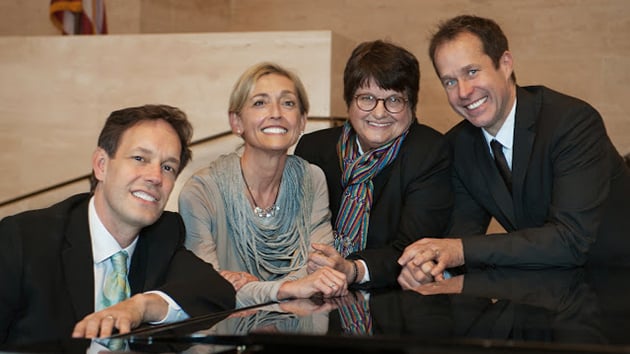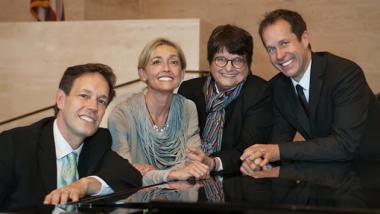
Sister Helen Prejean has been keeping Dead Man Walking alive now for 33 of her 75 years. The story, retold in her 1994 book and in an acclaimed 1995 film directed by Tim Robbins, began for the Baton Rouge-born nun when she became a pen pal, and later spiritual advisor, to convicted killer Elmo Patrick Sonnier, in 1982.
The tale of moral confrontation and spiritual redemption also became the source of one of the most widely-performed operas of the 21st Century, composed by Jake Heggie to a libretto by Terrence McNally, the first opera for both of its creators.
“There’s nothing more intimate than live drama and music,” testified Sister Helen, in San Francisco to help promote this month’s new production of Dead Man Walking by Opera Parallèle. “It’s the fullest form,” she continued, “because it takes you into places in your heart you didn’t even know you had.”
Sister Helen was joined by composer Heggie and company artistic director Nicole Paiement for a chat with SFCV, before an “In Conversation/In Performance” presentation to the public at Temple Emanu-El. “The relevance of this opera is what attracted us to it,” said Paiement, who’d attended the world premiere by the San Francisco Opera in 2000, with Susan Graham singing the role of Sister Helen (played by Susan Sarandon in the movie) and Frederica von Stade portraying the mother of the death-row inmate (renamed Joseph De Rocher in the opera). “One of the big missions with Opera Parallèle is to find operas that resonate with the 21st Century, to serve a purpose without being militant about it. We’re at the point of realizing the power of art to balance a lot of other things in this world.”
“We’re at the point of realizing the power of art to balance a lot of other things in this world.” – Nicole Paiement, artistic director, Opera Paralelle.As with the Robbins film, the opera’s story extends from the commitment of the homicidal crimes, through Sister Helen’s visits to the condemned prisoner, his grieving mother, and the bereaved parents of the two murdered youths, and on to the administration of punishment by lethal injection.
“It’s the only opera with a minute-and-a-half of silence in it,” Sister Helen pointed out. “It comes when they’re preparing De Rocher for execution, and before they start the Death Machine,” Heggie explains. “After the warden says ‘Proceed’” — the prisoner has been denied a last-minute stay — “an IV nurse comes out, disinfects the arm, and puts the needle in. What’s powerful for Sister Helen was that after she saw Patrick Sonnier die in front of her eyes, she knew she had to tell this story, because people were not going to be brought close to it otherwise.”
“And we go through the experience of both sides of the suffering on this issue,” Sister Helen added. “See, I got drawn into this not knowing what I was doing. And I made mistakes, like with the victims’ families: I stayed away from them. I didn’t know how to begin to handle them, they were so angry at me, because I was the spiritual advisor to the man who did this. But it was cowardice that made me stay away, and my editor helped me see that, after the first draft” of her book.
Her awakening was recalled in a phone call from Heggie, in the process of composition. “He said, ‘I want you to hear this, ‘cause I think we have the heart of the opera.’ It was so sweet, he played it on the piano and sang it, and it was this medley, where the victims’ families are singing, ‘You don’t know what it’s like.’ The mother of Joseph De Rocher is on the other side, ‘You don’t know what it’s like to see your child slip through your hands.’ And the Sister Helen character is in the middle, ‘cause I’ve done it all wrong with them. I’m thrown into something, and it’s my journey.”
Sister Helen praised McNally’s “genius” in “beginning everything with everybody seeing the murder, so there’s no energy in, ‘did he do it or not?’ He did do it.” “So all our energy goes into really getting to know the characters and following their journey,” Paiement agreed. “Terrence crafted a libretto where you witness every single person in their crisis and understand why they’re torn,” said Heggie. “You understand where Owen, the father of the murdered girl, is in his journey, where Joseph is, where his mother is, where Helen is, and where her ‘mother house’ [where she represents the church through service to poor African-Americans] is. They all want something, and it’s very hard to achieve. Terrence was very generous with me: He said, ‘I’m not a librettist, I’m a playwright, so what I’m gonna do is set up scenes and characters which I hope will inspire you. But if you hear music and the text doesn’t fit, follow the music, and I will catch up with you’.”
Heggie’s creative process was also spurred by dialogues with veteran opera composer Carlisle Floyd. “He gave me great advice about orchestration, ensemble writing, and traps to watch for. And the biggest thing was, everything’s in service to the drama, keeping the audience engaged and moving with you. He told me, you gotta use the vocabulary of your audience, then throw in some extra. But he was giving me permission to write from what I know.” “And there’s all kinds of music in the opera!”, Sister Helen interjected. “That was the brilliance of Terrence’s libretto, too,” Heggie continued. “Within the first five or six minutes of the opera, we have an orchestral prelude (which harkens back to classical), a rock ‘n’ roll tune over the radio, a jazz tune, and the conflict music of murder.”
“And what’s amazing is, you’ve just seen the murder, and there’s this juxtaposition, you hear the little children that we’re working with at Hope House,” Sister Helen noted, before herself starting to sing their hymn: “God will gather us around, all around.” She paused for a reverent sigh. “Every time I hear the music, its complexity and its beauty, it deepens it all in me, and I sing the opera for weeks afterward. It just rises up in me, I won’t even realize it’s happening.”
“Every time I hear the music, … it deepens it all in me, and I sing the opera for weeks afterward. It just rises up in me, I won’t even realize it’s happening.” – Sister Helen Prejean.
Still an active advocate for abolition of the death penalty (she was due to witness the Jan. 29 execution, by lethal injection, of Richard Glossip in Oklahoma, but the sentence was stayed), Sister Helen has also attended numerous productions of Dead Man Walking, and is impressed by its impact on diverse audiences. “A lot of young people who go to see it have never been to an opera in their life,” she said. “I think this may be one of the things that have begun to bring modern opera back in.” “Cinema has taken over, for many reasons,” added Paiement, “but opera can be a popular art form, and should be.”
“When people have a good first experience with opera, they can get hooked pretty easily,” assured Heggie. “And this is the exciting thing about Opera Parallèle and what it’s doing, because it’s not in the big opera house and it’s doing art which wouldn’t necessarily be done in the big house, connecting with a new audience.” This month’s production is being staged at the intimate Yerba Buena Center for the Arts Theater, with flexible sets, digital projections, and choreography by ODC’s KT Nelson. Heggie and Paiement have reorchestrated the score for an ensemble of 34.
In a company first, Opera Parallèle will take Dead Man Walking on the road to the Broad Stage in Santa Monica next month, after its San Francisco run. The opera has also successfully engaged audiences in Canada, Australia, Germany, and Austria. “This has been my goal from the beginning,” declared Heggie, who has gone on to write five additional operas, so far. “If you listen to classical operas, even if you don’t understand a word that’s being sung, you still know emotionally what’s going on. And that’s what I wanted to try to find: That even if an audience doesn’t understand English, they’ll still know what’s in my characters’ hearts.”

